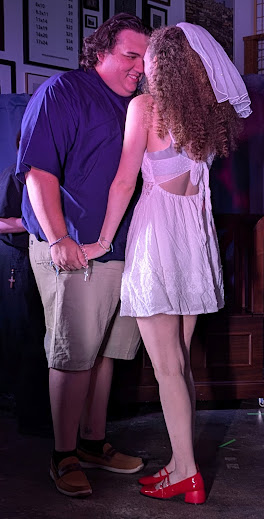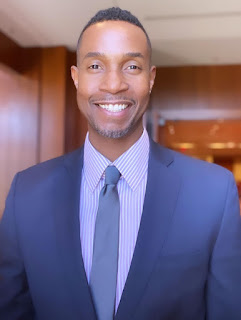ROMEO & JULIET
3 stars (out of 5)
Scrap Paper Shakespeare
Yours, Durham
Aug. 16 - Sept. 1
scrappapershakespeare.org
It’s one reason so many theatricals keep returning to Shakespeare: to search through ancient texts for something new. In recent years the region’s directors have found in Romeo & Juliet – a script now more than four centuries old – an accelerated culture’s addiction to immediate response and instant gratification, and the ghastly consequences of inculcating in the young the racial prejudices of the old. Even a critique of unchecked science found its way out of an improbable 1996 sendup/sequel at Chapel Hill's Forest Theatre, which – somehow – fused the famous star-crossed lovers’ text with the plot from the horror/sci-fi cult film Re-Animator. (Its name? Necromeo & Juliet.)
 |
| This actually happened. |
But Scrap Paper Shakespeare’s spirited new iteration, which closed Sept. 1 at an offbeat Durham photographic gallery space named Yours, took on different work.
With a notable ensemble of strong newcomers and rising actors anchored by stage veterans Simon Kaplan and Chloe Oliver, artistic director Emma Szuba's sometimes comic, sometimes pensive production underscored the immaturity – and catastrophically poor impulse control – not only of the familiar central characters, but the culture in which they lived.
It also underlined the titled couple’s youth as well. In an eerie ceremony during the chorus’s opening monologue, a symbolic prop or talisman was solemnly bestowed upon each character. It was jarring – but undeniably appropriate – when Juliet received a teddy bear.
 |
| Close, but not quite... |
For lest we forget, this snarky recent meme on social media nearly got it right: Ultimately, Romeo and Juliet records the fatal, five-day relationship between a 13-year-old girl – a present-day 8th-grader, in other words – and a boy who was maybe 17.
The friendship bracelet that actor Emma Roe sported was as indicative as the hot pink girly-girl diary her character blissfully scribbled away in. This Juliet was clearly a bubbly, curious adolescent – and not a terribly deep one at that – whose first contact with and discoveries about emotions involving attraction, infatuation and desire would tragically be her last.
As for Romeo, his level of emotional regulation showed up in the kvetching and whines of actor Joe Perdue in Friar Lawrence's chambers. The reluctant teen murderer had gone there to hide after killing Tybalt, Juliet’s hot-tempered cousin, not in self-defense, but for revenge after the duelist slew Romeo’s friend Mercutio.
No, we haven’t seen a director play this scene for laughs before. But when Romeo was unable to recognize his good fortune at being banished from Verona (instead of being merely put to death), an undignified meltdown that left Perdue laid out on the floor – as written in the script – earned well-deserved chuckles from the audience, while the bewildered Friar (a marvelously exasperated Andy Li) tried in vain to hide him. The comedy was only reinforced when Nancy Huffaker’s indignant Nurse distastefully nudged the floored, flaccid lover with her foot, cawing, “Stand up. Stand an you be a man!”
 | ||
| Nancy Huffaker as Nurse, and Emma Roe as Juliet |
Repeatedly this production made us wonder: Where were all the adults in fair Verona? For who in their right mind would train and arm a group of teenage boys in lethal swordplay, stoke them with not-so-ancient hatreds, put a cold Corona in their hands and then send them out, unsupervised, on the streets?
Oliver’s smug Samson and actor Grayce Anne Mosler’s boisterous Gregory seemed a laughable pair of day-drinking frat boys in the opening scene – albeit with concealed carry permits. But when their beery machismo sparked a larger fight than they were ready for, they panicked, as children do, and the eventual senseless bloodbath was guaranteed.
Functional adults also know how to deal with anger and frustration. But when even the oldest characters in Szuba’s production were incapable of basic anger management at home, the real roots of Verona’s civil strife became apparent.
In one of this production’s tenderest moments, Kaplan's Lord Capulet gently comforted Juliet for her tears, ostensibly for the slain Tybalt, when he murmured, with concern, “[T]hy sighs, / Who, raging with thy tears and they with them, / Without a sudden calm, will overset / Thy tempest-tossèd body.”
Then, not three minutes later, Capulet threatened to disown her utterly when she refused to marry another suitor, Paris: “[H]ang, beg, starve, die in the streets,” he hectored, “For, by my soul, I’ll ne’er acknowledge thee, / Nor what is mine shall never do thee good.”
After this same man said to Paris, a day before, “My will to [Juliet’s] consent is but a part. / And, she agreed, within her scope of choice / lies my consent and fair according voice,” the velocity of Capulet’s rage was as evident as its utter irrationality. A capacity for such seismic shifts, without warning, doesn’t make for stable relationships. A Capulet who turns like this on his own daughter is clearly capable of doing far worse in a neighborhood quarrel. |
| The Lady and Lord (Chloe Oliver & Simon Kaplan), at the Capulet's feast |
Under Szuba’s direction, a blasé but perfectly coiffed and clad Oliver (in a double role) had already demonstrated Lady Capulet's own arrested emotional development earlier, while giddily endorsing a sudden marriage to the ever so socially awkward Paris (a second comic coup for the double-cast Li). When Lord Capulet’s wrath fell full force on Juliet, she was too busy being a trophy wife to offer any comfort or support.
And as her family failed, Juliet's flimsy social safety net only made all matters worse. For what responsible religious leader would marry two teenagers a day after their first date? And what older caretaker would abet that union behind the backs of the child’s parents, her employers?
When the Friar and Nurse were the closest that any adults in this world came to possessing wise counsel or emotional maturity, the titled pair were truly doomed.
Thus, this production showed Romeo and Juliet not to be an ageless love story, but the
document of a community’s collapse instead. As immature adults behaved like kids, they left the real
children wholly unprotected. Tragedy inevitably followed.
===
Scrap Paper Shakespeare's scrappy, go-for-it aesthetic frequently involves creating stagings on a shoestring budget, and making available spaces work, no matter how far they are from ideal. Integrity in the acting and directorial concept – as opposed to sumptuous sets and technical wizardry – are key, and this production of Romeo and Juliet certainly delivered.
Until, that is, it didn’t: quite abruptly and, worst of all, during the final act.
The ambitious young company's notable 2023 production of Shaw’s Arms and the Man made our best-of-year list in part for staging a play of that complexity on what we termed “a postage stamp-sized set,” wedged between two pillars at Durham's long-time alternative performance venue, The Fruit.
But in the even narrower studio space at Yours the company found a point of diminishing returns, as the venue forced compromises on the show, some more troublesome than others.
Arrayed from floor to ceiling, the studio's photographic bric-a-brac remained a distraction throughout the show, as did a vending machine for Kodak film, whose LED display kept scrolling the words "out of order." The office wall clock above the stage, which kept us posted on the correct time throughout the show, was also disconcerting.
(We'll have to see if these still pull our focus when the company returns to stage Claire F. Martin's Arabella in December.)
Ian Winek’s effective fight choreography minimized the disappointment when this production had to substitute knives for swords in the famous third-act fight between Mercutio (a memorably roisterous Callie Banholzer) and Tybalt (steely Collins Wilson).
 |
| Juliet (Emma Roe) & Romeo (Joe Perdue), on the crowded dance floor at the Capulet's feast |
But the final failing glitch came when this staging prevented between a full third to one half of the audience, included those of us seated on the third row, from viewing the climax of the play in the dramatic closing scene in the Capulet crypt.
In the absence of risers that might have raised the action on stage to a place where it could be visible (or elevated the back audience bank to a point where they could see), the patrons in the front two rows blocked the view of those behind them to all events taking place just above the floor.
In this staging, that included the moving final moments of the title characters' lives, and their subsequent deaths.
That is unacceptable for a production of Romeo and Juliet.
It’s a theater's first responsibility to provide seating from which audience members can actually see their production. When a company doesn’t fulfill that obligation, professional acting and directorial excellence are irrelevant; audiences cannot value – and may well not return again – for what they cannot see.
===
But let's close this essay in praise of something I could observe.
 |
| Perdue & Roe, as Romeo & Juliet |
It took courage for Szuba to cast Perdue, a larger-bodied actor, as an unconventional Romeo, and it took courage for him to take the role in turn. But in so doing, this production not only questioned the ranges of human forms that deserve to be loved, but broadened them as well, in a victory for larger-bodied people, and for us all.
That was something worth seeing, indeed.


















